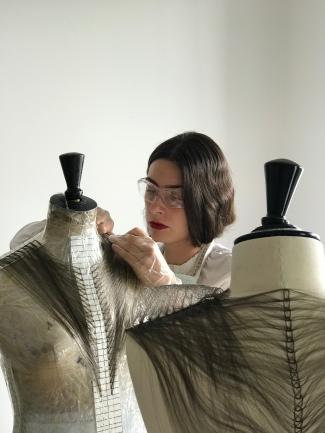In search of the forgotten queens with Jeanne Vicerial | Exhibition Au-delà
Jeanne turned to clothing design as a teenager.
After studying costume design and obtaining a Master's degree in Clothing Design at the École des Arts Décoratifs de Paris in 2015, she embarked on a research project that took the form of a doctoral thesis SACRe (Sciences, Arts, Creation, Research), which she defended in 2019.
She deepened her research by developing, thanks to a partnership with the mechatronics department of MINES ParisTech, a patented robotic process that enables the production of tailor-made garments without dropping. At the same time, she became involved in an artistic process that led her to found the Clinique vestimentaire research and design studio, after a spell with Hussein Chalayan.
In addition to her personal creations, she quickly initiated numerous collaborations with artists from different backgrounds: photographers, sculptors, performers, choreographers, musicians, perfumers, etc.
Resident at the French Academy in Rome - Villa Medici in 2019-2020, her creations have been exhibited at Lafayette Anticipations in Paris (2023), at the Palais de Tokyo in Paris (2018), in Rome (Villa Medici and Palazzo Farnese, 2020), at the Collection Lambert in Avignon (2021) and have recently joined the collection of the Cnap (Centre national des arts plastiques).
Transcript
Jeanne Vicerial, artist and researcher.
I work mainly with threads and ropes, so I never use fabric in my work. The main technique is tricotissage, which is a technique that was originally inspired by human muscle tissue. I have copied some kind of human anatomy patterns from science books. I was inspired by muscle weaving.
The works in the exhibition Au-delà are entirely handmade with a palette of threads. That is to say, it's like a pen palette with a thread as thin as a hair and a thread as thick as rope, creating a kind of three-dimensional drawing directly in the space.
Each workpiece requires between 200 and 1200 hours of handwork, so there is also this relationship to time which is important in this technique. So there is the technique of knitting and related techniques such as macramé, lace and ancestral rope techniques.
The installation in the exhibition features a Gisante (funeral sculpture) accompanied by two Presences. This Gisante is the first one I made in the studio. It is an earlier stage of what happened at the St Denis basilica, the installation that took place there as part of the Monde Nouveaux programme. It was the idea of having a re-reading of this heritage which is also the largest necropolis in Europe where the Kings and Queens of France are present but there are few traces of women's voice. The idea was to intervene without necessarily being invasive, but to give a voice to the past in order to try to understand a few notions of the present. It was also a question of being part of a place where patriarchy has been present throughout history and also of realizing that, over time, there are many queens who are presented anonymously, which is also a way of giving them a voice and of considering this necropolis as a sort of body laboratory. We came with the workshop to take measurements in a non-invasive way, to try to study them in order to reconstitute bodies in a sleeping state, like the lying women, but also in an awake state like the Presences. That is the idea of this installation. And then there is also the presence of the relics, which gives the name to a basilica, here is oniricly presented by a work with the flowers which represent the flora of these lying women.
In this installation, there is really the idea of this lying woman who is ready to wake up accompanied by two bodies that are already in a state of awakening in a kind of levitation.
One of the Presences next to the Gisante is also a piece, a totem that I made for the choreographer Hervé Robbe: it was both an inert body and also animated by the work of four dancers who come around the piece, which is called Sollicitude, to animate this presence. There is also the relationship to ritual and the activation that can take place and so these installations can also be animated by the presence of dancers or actors.
